Turkey Vultures: Photos Reveal an Icon of the American West
Majestic West
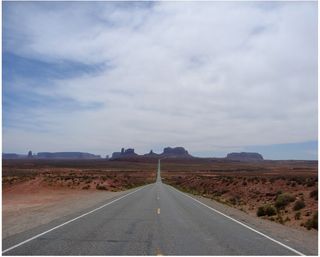
The American West has long been as much of an idea and a dream as an actual place. This land west of the 100th meridian is characterized with a climate best described as semi-arid and an average elevation above 2.000 feet. Vast regions of the land are still barren and experiencing majestic landscapes can still be a common and daily occurrence.
Saguaro forest
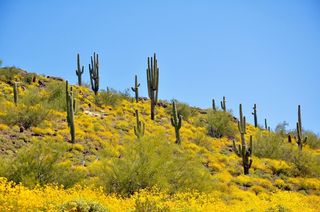
Many symbols have come to represent the American West, including the large-eared jackrabbits, the solitary miner leading his laden mule, the lonely cowboy and, as shown here, a forest of saguaro cacti, Carnegiea gigantea, standing on an isolated mountainside carpeted with spring wildflowers.
The 'Ole Buzzard

But one of the more unique symbols of the American West, since it most always appears as a result of another animal's death, must surely be that of the "ole buzzard" — more accurately called, the turkey vulture.
A desert fixture
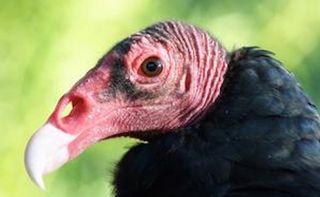
The turkey vulture, Cathartes aura, is one of the most common and widespread "raptors" in the Western Hemisphere. They range from southern Canada south through the United States, Mexico, Central America to the lowlands of Argentina and Chile. Their large, hooked bill is the ideal feeding tool for ripping apart carrion without ever ruffling or messing a single feather on their distinct red, bald head.
Big creatures

Turkey vultures are nature's consummate scavenger. They are large, dark birds, often more brown than black. Only eagles and condors are larger raptors than the turkey vulture. Their wingspans can vary between 5.5 and 6.5 feet (1.6 to 2 m) and they range in weight from 2 to 4.5 pounds (0.9 to 2 kg). They look somewhat awkward and ungainly on the ground and exert great effort to launch themselves into flight.
On the hunt
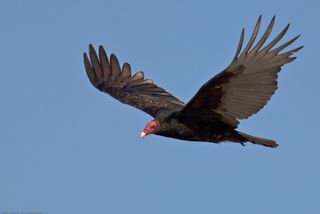
Turkey vultures are commonly seen soaring overhead on the air thermals in search of carrion. They usually search in small groups, often circling around and around smelling for their dead food. They have long finger-like feathers on their wingtips and tail feathers that extend beyond their legs. When they soar, they hold their wings slightly raised, creating a "V" shape when seen from the front or rear. The undersides of their flight feathers are whiter, giving the turkey vulture a two-toned look. They often teeter while in flight and seldom actually beat their wings.
Gregarious animals
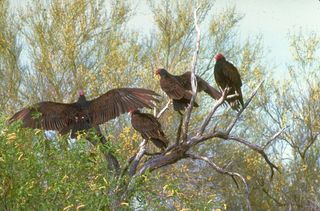
Turkey vultures are very social birds, gathering in groups numbering from a few to over 100. They do not have a voice box like other birds, so they communicate with other vultures only with a series of grunts, hisses and bill clacks. A group of vultures will often feed without conflict together on a carcass, and such a feeding group of vultures is known as a "wake" of vultures. At night, they roost in trees and remain there until several hours after sunrise when the warm thermals of air allow them to rise again high into the sky. A flock of vultures riding the thermals through the sky is called a "kettle."
Sign up for the Live Science daily newsletter now
Get the world’s most fascinating discoveries delivered straight to your inbox.
Livin' the life

Turkey vultures feed almost entirely on carrion. When they locate a carcass by smell or sight, they quickly land and begin feeding before other predators arrive. Their bare heads allow them to feed on rotting flesh without bacteria or other parasites burrowing into any feathers and causing infections. The vulture's stomach acid is more corrosive and stronger than that of other birds, and can thus kill any harmful bacteria that could be in the decomposing meat. Regurgitation of these strong stomach acids is also used by the turkey vulture as an effective defense mechanism. They also frequently urinate on their legs, which not only helps cool them during hot days but also kills any bacteria or parasites they might have picked up from eating or standing upon a putrefied carcass.
Family life
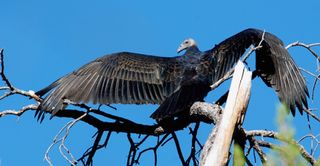
Ornithologists believe that turkey vultures mate for life. The mated pair do not build a nest, but rather the female lays her eggs on rock ledges, hollow trees, caves, animal burrows or simply on the ground. Most clutches are made up of two, dull white eggs with tan, brown or purple blotches. Both parents take part in incubation, which lasts from 38 to 41 days. The young weigh only 2 ounces (57 g) when hatched with dark faces and are covered with white down. Both parents feed the young with regurgitated food. Young turkey vultures, like the one shown above, fledge for 60-84 days during which time their heads remain gray. Once they take flight, most will continue to follow their parents on foraging flights and join the communal roosts.
Cousins
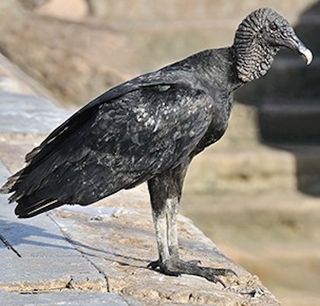
The turkey vulture is the most widely distributed of the seven vulture species found in the New World. But their close relative, the black vulture, Coragyps atratus, shown here, is the most numerous vulture in the Western Hemisphere. Commonly found in the northeastern United States, Mexico, Central and South America, the black vulture is a compact bird with broad wings, a short tail and powerful wingbeats. They often make up for their poor sense of smell by following turkey vultures to rotting carcasses. Black vultures are highly social birds and form stronger family bonds than that of the turkey vulture.
Dangers of the world
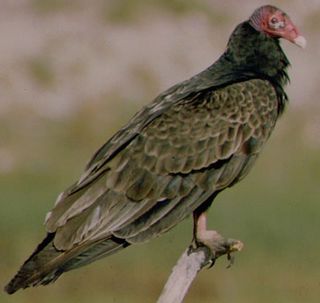
The population of turkey vultures across North America seems to have stabilized with the reduction of use of DDT and other pesticides. Poisoning is still their greatest threat from both environmental toxins and the lead from bullets in the carcasses that they eat. Many vultures are hit by cars as they stand on the roadway eating roadkill. Collisions with power lines often causes electrocution of these large birds. As with all wildlife, loss of open, natural habitat can result in a quick decline in the local turkey vulture population.
